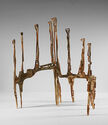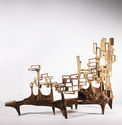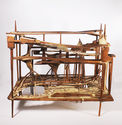
19th, 20th & 21st Century Fine Prints
707-546-7352 · fax 707-546-7924 · web: www.annexgalleries.com · email: artannex@aol.com
Pamela Boden Biography
Pamela Boden
British / American
1905–1981
Biography
Pamela Boden, sculptor, designer, and draftsman, was born in Derbyshire, England on April 23, 1905. She was principally home-tutored except for one year at Heathfield Girls' School in Ascot, England. When she was seventeen, her family moved to Germany, where she studied music and art in Dresden and Munich. She also studied life drawing in Paris at the Académie de la Grande Chaumière.
In 1927, Boden moved to the South of France, where she began writing an irreverent novel, Persian Paradise. Her book was never published (in fact, it was politely rejected by T.S. Eliot for its content in 1936 when he worked for Faber & Faber, Ltd.), but her writing set the tone for the attitude and irreverence she displayed in her future work, whatever the medium.
Boden returned to Paris and began to associate with the artistic community and met the English composer Stanley Bate, whom she briefly married (as a joke; they were both gay) and who exposed her to the contemporary music scene where she met the avant-garde Australian composer Peggy Glanville-Hicks. Boden’s circle of friends included the Surrealists, Dadaists, and Cubists who converged on Paris in the 1920s and 1930s, including sculptors Hans (Jean) Arp and Ossip Zadkine; the painter Albert Gleizes; and the Portuguese writer and film maker Virginia de Castro e Almeida, with whom Boden began a relationship that lasted until Virginia’s death in 1945.
At age twenty-seven, Boden began to carve decorative panels but soon turned to three-dimensional sculpture. In 1936, she exhibited at La Salon d’Automne with Albert Gleizes’s group and, in May 1938, she had a solo exhibition of her wood sculptures at Quatre Chemins in Paris.
In 1938, Pamela and Virginia moved to Portugal where Pamela illustrated a number of Virginia’s books and exhibited her sculpture in Lisbon. Stanley Bate had joined the Arts Theatre group at the end of 1939 and revived his score for the ballet Perseus. He commissioned Boden to design the decor and costumes while Keith Lester provided the choreography and Harold (Hal) Turner danced the title role. Perseus was performed in London on 2 July 1940 at the Arts Theatre Club.
In November of 1940 Boden, Antonio Dacosta and Antonio Pedro organized the first Surrealist exhibition, titled EXPoem Esculture e Pintura at Repe House in Lisbon, Portugal, which was a key exhibition in Portugal for modernism. Boden exhibited six of her carved and assembled wooden sculptures.
After Virginia’s death, Boden immigrated to the United States, ultimately settling in New York. In February 1946, she exhibited in a two-person show titled 5 Sculptures / Pamela Bodin (sic) / Clyfford Still: First Exhibition - Paintings from February 12 to March 7 at Peggy Guggenheim’s Art of this Century at 30 West 57th Street. The show was held in one of the four exhibition spaces, the Daylight Gallery. Boden exhibited five sculptures carved from Portuguese “cyclone-felled cedar” which were placed in the center of the gallery, surrounded by Still’s paintings. The show was scheduled to run between February 12 and March 2 but, due to a city-wide strike, received little press coverage and was extended to March 7. Additionally, her name was misspelled in all of the marketing leading up to the show, and thus she was not provided the exposure an artist would otherwise have gained by exhibiting at Peggy Guggenheim’s gallery. Despite these setbacks, comments on Boden’s work were favorable, including that of art critic Emily Genauer who praised Boden’s work as “highly original, sharply rhythmic in their organization, and full of clean strength.” The Art News review appraised the work as having “considerable ingenuity” with their “sharp, deep cuts, leaving the coarse grain mostly unpolished, and often used knotholes.”
Wanting a change of scenery, Boden, who was drawn to the high desert country, moved to Taos, New Mexico in 1946 and remained there until 1955. During this period, she showed with La Galeria Escondida, operated by Eulalia Emertaz in Taos, New Mexico, which was also exhibiting work by Richard Diebenkorn, Ed Corbett, Bea Mandelman, Louis Ribak, Andrew Dasberg and other Modernist painters living in Taos. In 1948, the visionary filmmaker Elwood Decker presented her sculptures in his avant-garde abstract film Color Fragments.
In August of 1948, the American Contemporary Gallery in Los Angeles announced it was “Introducing Fantastic Sculpture by Pamela Boden.” The exhibit was actually a two-person show which featured wood engravings by Rouault. The gallery, located at 6727-1/2 Hollywood Boulevard was run by Barbara Byrnes and Clara Grossman and exhibited works by leading Surrealists and showed experimental films by European Surrealists and Modernists. Elwood Decker created an experimental film for the opening of Boden’s show that used her sculptures, flexible mirrors, and other film techniques he had developed.
Boden moved in 1955 to Los Angele, where she showed at the Paul Rivas Gallery and her work was exhibited at the Los Angeles County Museum of Art. After three years, Boden made her final move to the San Francisco Bay Area, settling in Marin County. She perfected her sculpture technique, which had evolved into carefully cutting, shaping, and gluing together small pieces of wood into Surreal landscapes, birds and animals. Boden kept them unpainted, the only color being the wood and the “wood maché” mixture she learned from sculptor-friend Robert Cremean. The maché was made of glue, sawdust and modeling paste, used like plaster that she added to create and secure the forms. Her work was included in the biennial exhibition American Contemporary Painting and Sculpture 1963 at the University of Illinois in Urbana. The following year a solo exhibition of her sculpture opened in the spring at the Richmond Art Center. She also exhibited in the San Francisco Bay Area at the David Cole Gallery, the San Francisco Museum, Stanford University, and Ann O’Hanlon’s Sight and Insight Gallery.
In 1978, the Australian composer Peggy Glanville-Hicks, with the help of music critic James Murdoch, arranged for an exhibition of Boden’s sculpture in Sydney at the Australia Music Centre, Gallery A, between May 13 and June 3. Seven sculptures were selected and Glanville-Hicks contacted composer friends to write a musical score for each sculpture in the show. The exhibition consisted of the following works: 1) Girondelle for Giraffes: composition by Australian Peggy Glanville-Hicks; 2) Rocking Horse: composition by Australian Ross Edwards; 3) The Magician’s Castle: composition by Australian Don Banks; 4) Gambol: composition by Australian Peter Sculthorpe; Mountain Torrent: composition by American Lou Harrison; 6) Estuary: composition by Australian Vincent Plush; 7) Horses Fleeing: composition by Australian David Gulpilil. (David Gulpilil Ridjimiraril Dalaithngu was a skilled Aboriginal Australian dancer, tracker, hunter and musician who achieved an international reputation as an actor in the 1970 film Walkabout. Gulpilil composed his work on the didgeridoo.) During the exhibition, each sculpture was placed on a rotating base and a spotlight moved from one sculpture to another and as it stopped at a work the piece of music was played. The exhibition traveled on to the Tolarno Gallery in Melbourne.
Pamela Boden died in Inverness, California on August 1, 1981.
A variation of this biography appears with many illustrations in the book Emerging From the Shadows: A Survey of Women Artists Working in California 1860-1960 by Maurine St. Gaudens, volume I, 2015; ISBN978-0-7643-4861-7









